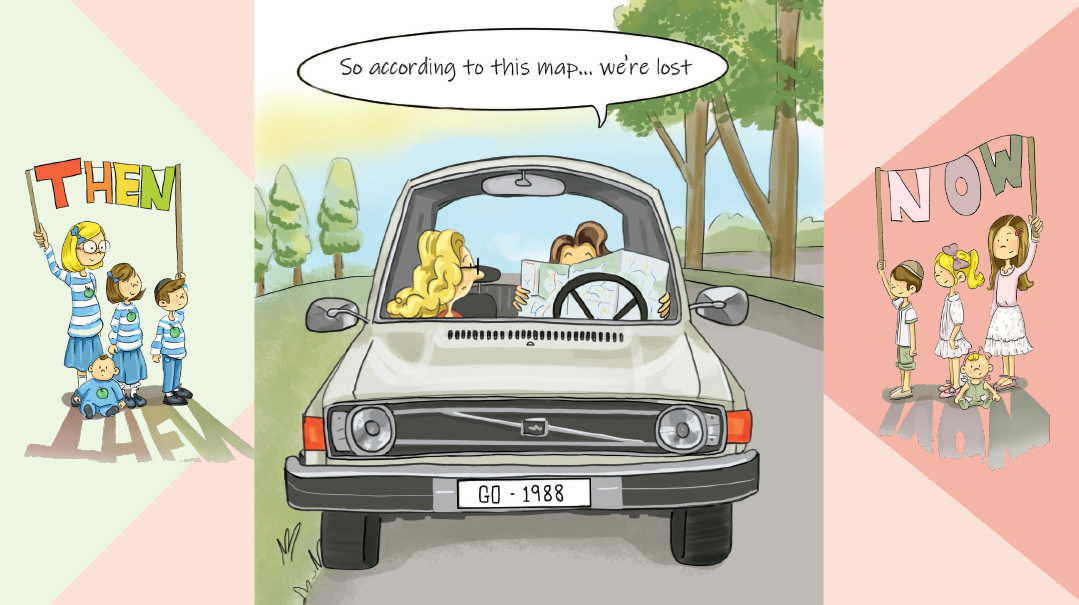Beyond the Page

Two writers apply writing axioms to real life

WE
talk writing a lot.
As writers, as writing coaches, as word-lovers and word-crafters, writing truths like Character is plot or Keep it in the active voice are a regular part of our conversation — and not just when we’re working.
One of us will be creating a tablescape and will want to pack it all in, pale-pink roses and hot-yellow daffodils and every vase we own, but then we’ll hit pause, because Less is more.
Or a child comes home from school upset about class politics and we sigh and figure someone else will phone the teacher, and then remember that taking an active stance over a passive one is almost always the way to go.
When the axioms are there in your work, when you know them in your sleep and use them every day, they come to haunt you and to help you in life. Here’s how:
SHOW, DON’T TELL
Want your readers to understand something about your character, their relationships, or the scene that’s happening? Show them, don’t tell them.
Spot the difference between these pairs of sentences:
1: Dina was tired.
2: Dina’s eyes were closing of their own accord. She forced them open, trying to focus on the screen.
1: It was cold.
2: She could feel the frost in the air and quickly pulled her scarf over her cheeks.
1: Eli was running late.
2: Eli panted toward the bus stop, missing his bus by a second. NO!
In each of these examples, the first one tells a fact, while the second paints a scene. And that’s a lot more interesting — and memorable.
In real life…
We love telling people things. Showing, though… that requires more thought and effort. Consider these real scenarios:
Sara’s challenging marriage had ended, and she was desperate for support and practical help in her new role as a single mom. But while several friends offered sympathy, or texted things like, “I’m here for you,” she didn’t feel like they were. Words are just words; didn’t someone realize that sending supper or hosting her for a Yom Tov meal would be more helpful?
Elisheva was struggling with her new teaching job. A veteran morah passed by and offered to help her “in any way.” But she didn’t follow up, and the offer was too vague for Elisheva to feel like she could ask.
Chava quit her full-time office job because, as she regularly boasted, “My children are my top priority.” But her nine to five hours were quickly replaced by a home-run side business, an active social life, and chesed work for N’shei. Her words told one story; her actions revealed another.
When it comes to statements about our values, offers to help others, or commitments, Show, don’t tell applies all the way. Anyone can say it, but when you do something about it, the statement means a whole lot more.
Instead of telling someone you’re there for them, or that you’ll do anything to help, go ahead and do something — offer babysitting, a meal, a contact, an invitation, cleaning help, or financial support. Instead of stating your top priority, make it abundantly obvious — by what you choose to give attention to, focus on, dedicate time to, or place first when two priorities collide.
Let your actions talk for you, and your statements will be all the more powerful.
LESS IS MORE
Once upon a time, people had ornate wallpaper, embellished teapots, and long, luxuriant attention spans. Now, with technological advances and the action-oriented film industry, writing styles are all about minimalism, speed, and ease to accommodate skim-through, read-the-bold, what’s-the-gist attention spans.
In fiction, this translates into less description of places and people. The reader won’t stick around while you paint the setting onto canvas for them. It’s not that description goes out the window, but rather that the focus changes to description of action or expression. There’s less of the surroundings, more of the happenings.
In real life…
It’s not just in writing that Less is more. It applies when you’re hanging photos on a wall, placing furniture in a room, or designing a tablescape. When there’s too much in one space, it just gets… well, too much. Text and pictures need space. White space is all-important.
And what about Less is more in speech? As Mark Twain famously said, “I apologize for such a long letter, I didn’t have time to write a short one.” It takes time to clarify your message and pare it down to what you really want to communicate, but it shows the other person that you value their time, your message, and them.
“I’m sorry about what happened yesterday,” Tova told Avigail.
Avigail’s heart lifted. She’d been so hurt by the way Tova had snubbed her at last night’s event, switching seats halfway through the event to sit with camp friends, and leaving Avigail alone and awkward at another table. An apology meant Tova realized what she’d done, that she understood how Avigail had felt.
“It was just that…” Tova continued, and Avigail wanted to scream. She didn’t want explanations or excuses. In one moment, the apology lost all its contrition. Why couldn’t Tova have just left it as a simple, heartfelt, “I’m sorry”?
It happens with apologies, and excuses, and even asking for favors.
“Can you please watch my kids after school tomorrow?” Ayala asked her neighbor. “I thought you wouldn’t mind because they finish school at the same time as your kids anyway. And something came up, and I couldn’t find a babysitter, you have no idea how much I tried….”
We do it a lot — hedging, explaining, or defending our requests. But often, it’s best to just spit it out. People are more likely to help you if you can be confident and quick about your request, rather than cushioning it in suffocating explanation.
TAKE THE ACTIVE ROUTE
Which sounds better: “The man sat in a chair” or “A chair was sat upon by the man”?
If you are aiming for drama and pomposity, the latter might work, but in most cases using the active voice will make your writing more concise (active voice is typically 20 to 30 percent shorter than passive voice) and clearer (active voice clarifies who is doing what).
If you have reason to hide who’s doing the action (“Last year, mistakes were made!”) or if the agent in the sentence is truly unknown or unknowable (“She was mugged!”) then by all means use the passive voice.
But default back to the active voice as soon as you can.
In real life:
Complaining is often our default. We’re skilled at whingeing, griping, and harping on. But talk is cheap. You don’t like something, so do something. Don’t wait passively by for change. Start doing and He will do for you in turn.
Think of the international organizations that have become tremendous forces of chesed in our own community. United Hatzalah, Renewal, Dor Yesharim — all these were created because someone saw a need and stepped up to the plate.
As Ghandi said, in a hard time, “Be the change you want to see in the world.” He went on to lead the campaign for India’s independence from British colonial rule.
Start doing, and see what happens. You can be that change in your home, in your community, or in your child’s school.
CHARACTER IS PLOT
Character is essential to the plot, not a tacked-on afterthought. A plot in which the central character could be replaced with just anyone, without the plot changing, would be lacking.
Think: a Mossad-based thriller in which the agent could be a middle-aged, sharp-nosed loner, or a young, overeager, family-minded new recruit. If the storyline isn’t influenced by his emotions and personality, if the plotline doesn’t change based on how this unique character would respond to a situation, it’s only half a story.
In real life:
We see circumstances. We don’t always see the characters.
The plotline of someone’s life — a struggle with shidduchim, a child in the hospital, a loss — might be something we are familiar with. But to truly understand the nuances, we need to look at the person themselves: how they’re reacting, how they’re feeling about it, how their personality and background and total life story contribute to what they might be going through.
And then, we need to tailor our responses accordingly. A gregarious and talkative close friend who is always surrounded by family and friends will need something very different from the introverted coworker who shies away from crowds and gets overwhelmed by multiple conversations happening at once — even if both are going through the same exact challenge.
Look at the person, not just the situation, and you’ll be that much closer to answering the question: What does this person need from me right now?
GO DIRECT
Shira was feeling overwhelmed at work and asked Esther to stay later to help her out. Esther replied that she’d extended herself enough for her job and wanted to set some boundaries.
Meh.
Consider this:
“You can’t do this to me,” Shira said, voice rising in panic. “You absolutely cannot leave me to deal with this… mess… on my own.”
“I feel bad,” Esther replied, her tone implying anything but. “But I have a life, too. I can’t stay late every day. I have to set some boundaries.”
More color, more power, and so much more vivid.
Instead of reporting what happened, use direct quotes whenever possible to draw the reader into the scene. It gives so much more flavor and detail, and helps you better understand the character. Shira, for example, sounds like she’s falling apart in the second example, whereas in the first, she could just as easily have been mildly stressed and asking for a quickie extra favor.
In real life…
Broken telephone.
Need we say more?
It’s so easy to get lost in the messages… she said this, he said that, and somewhere along the way, voices are scrambled, tones become garbled, and communication goes awry.
When Libby heard that her sister Batsheva was also moving in with their parents for Pesach, she was upset. Batsheva’s kids were like their mother: confident, assertive, (bossy?!) little personalities who left their shyer, more sensitive cousins in the dust as they raced around Bubby’s playroom, playing some make-believe game.
She confided in her mother about the problem. “My kids and Batsheva’s have never been the greatest mix,” she said. “You know how they are… my girls always end up in tears, and Chaim’s too quiet to join in their games….”
Her mother offered to speak to Batsheva and try to come up with a plan, and Libby gratefully accepted — she wasn’t sure how to tell her opinionated big sister about the problem herself.
But the easy way out backfired. Batsheva was hurt that her sister and mother were talking about her kids behind her back, and she was confused about what Libby expected her to do. “My kids aren’t doing anything to yours!” Batsheva angrily texted her sister.
Libby quickly regretted not having mustered up the courage to pick up the phone herself. She could’ve couched it as something they could collaborate to resolve: “My kids are shyer than yours, what can we do to help them join in the games?”
Going direct might have felt harder, but in the long run, it would have saved so much tension and aggravation — and brought about a real solution, instead of them tiptoeing around the awkwardness for yet another Yom Tov with the family.
Takeaway? When it’s possible, when it’s important, especially when the subject matter is sensitive, go direct! Nothing compares to a direct conversation with the other party, rather than taking opinions, messages, and reports from others.
LEAVE WHILE THE GOING’S GOOD
Ending a story is an art of its own. When you get there, don’t tie everything in a bow; leave it as a classy knot. Readers want some form of resolution, a breath of hope, a feeling that something has changed, but they don’t need to know exactly what and how and where the characters go from here. No one wants to read the too-perfect happily ever after, because life… it just ain’t. Leave off realistically, while readers are still held by the anticipation you built up, and your ending will pack a punch.
In real life…
You’re having a good time, things are going well, cue door.
It sounds a bit much, and I’m not a party pooper, but consider this: You’re at a wedding and the dancing is leibedig, fun, and then it goes on — and on. People are sweating, their energy flagging, the same dance step repeating itself over and over.
Or this: You’re teaching, and someone asks a bomba kashe, and you think how to respond and start to answer from your heart. You’ve got them, like you never had them before. And then the bell goes. It didn’t ruin your minute, it made it. Because if you’d have gone on, used more words, you’d have just lost the potency.
And when it comes to vacation… three days means happy kids wishing they could stay longer. Four days and there’s something wrong with the place and they’re whining to go home.
Leave them wanting more.
There’s always more to say on writing and life. But… going back to that last little point we made.
Our parting words: All of life’s a story. And with these rules, you’ll be better equipped to write it.
Rivka Streicher and Rochel Samet are regular contributors to this magazine, and co-creators of the Summer School of Writing, an eight-week program designed to help new writers begin publishing, and experienced writers hone their craft even further. They can be reached at info@summerschoolofwriting.com or www.summerschoolofwriting.com.
(Originally featured in Family First, Issue 847)
Oops! We could not locate your form.







